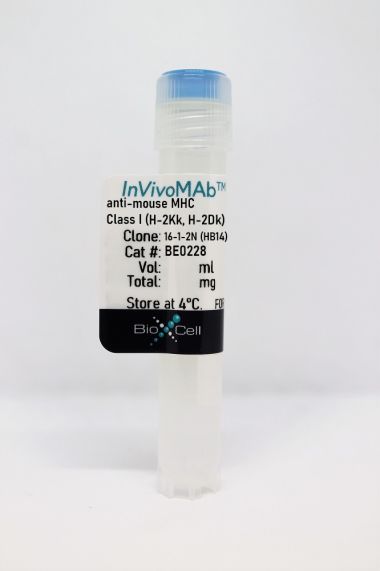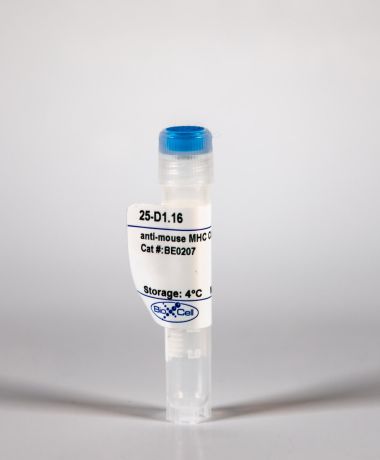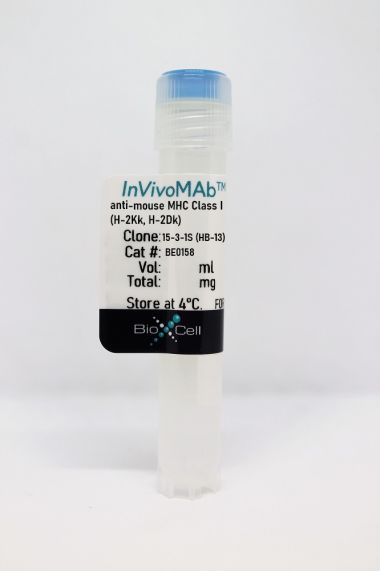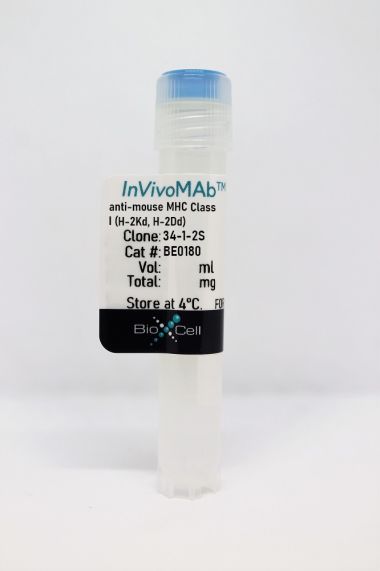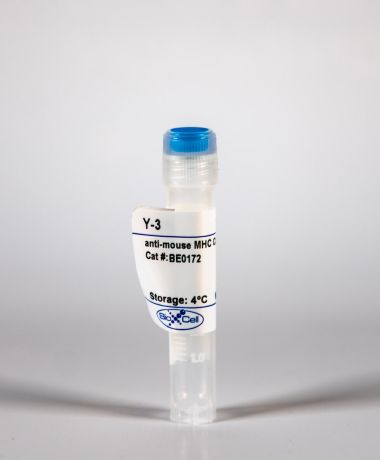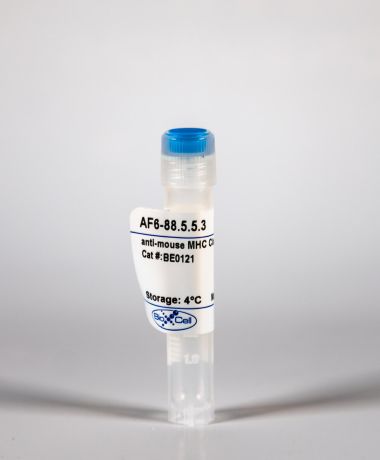InVivoMAb anti-swine MHC Class I (SLAd)
Product Details
The 74-11-10 monoclonal antibody reacts with the swine leucocyte antigen (SLA) class I. This corresponds to the major histocompatibility complex (MHC) class I. Class I antigens are expressed on the surface of all nucleated cells with the exception of neurons and trophoblasts. SLA plays a key role in the immune response against grafts or transplants, but also in the control of antigen presentation and the development of the immune response. Antigen presentation to CD8 T cells is one of the main functions of SLA class I.Specifications
| Isotype | Mouse IgG2b, κ |
|---|---|
| Recommended Isotype Control(s) | InVivoMAb mouse IgG2b isotype control, unknown specificity |
| Recommended Dilution Buffer | InVivoPure pH 7.0 Dilution Buffer |
| Conjugation | This product is unconjugated. Conjugation is available via our Antibody Conjugation Services. |
| Immunogen | dd miniature swine thymocytes |
| Reported Applications | Flow cytometry |
| Formulation |
PBS, pH 7.0 Contains no stabilizers or preservatives |
| Endotoxin |
<2EU/mg (<0.002EU/μg) Determined by LAL gel clotting assay |
| Purity |
>95% Determined by SDS-PAGE |
| Sterility | 0.2 µm filtration |
| Production | Purified from cell culture supernatant in an animal-free facility |
| Purification | Protein G |
| RRID | AB_10949301 |
| Molecular Weight | 150 kDa |
| Storage | The antibody solution should be stored at the stock concentration at 4°C. Do not freeze. |
Recommended Products
Flow Cytometry
Munoz-Gonzalez, S., et al. (2015). "Postnatal persistent infection with classical Swine Fever virus and its immunological implications" PLoS One 10(5): e0125692. PubMed
It is well established that trans-placental transmission of classical swine fever virus (CSFV) during mid-gestation can lead to persistently infected offspring. The aim of the present study was to evaluate the ability of CSFV to induce viral persistence upon early postnatal infection. Two litters of 10 piglets each were infected intranasally on the day of birth with low and moderate virulence CSFV isolates, respectively. During six weeks after postnatal infection, most of the piglets remained clinically healthy, despite persistent high virus titres in the serum. Importantly, these animals were unable to mount any detectable humoral and cellular immune response. At necropsy, the most prominent gross pathological lesion was a severe thymus atrophy. Four weeks after infection, PBMCs from the persistently infected seronegative piglets were unresponsive to both, specific CSFV and non-specific PHA stimulation in terms of IFN-gamma-producing cells. These results suggested the development of a state of immunosuppression in these postnatally persistently infected pigs. However, IL-10 was undetectable in the sera of the persistently infected animals. Interestingly, CSFV-stimulated PBMCs from the persistently infected piglets produced IL-10. Nevertheless, despite the addition of the anti-IL-10 antibody in the PBMC culture from persistently infected piglets, the response of the IFN-gamma producing cells was not restored. Therefore, other factors than IL-10 may be involved in the general suppression of the T-cell responses upon CSFV and mitogen activation. Interestingly, bone marrow immature granulocytes were increased and targeted by the virus in persistently infected piglets. Taken together, we provided the first data demonstrating the feasibility of CSFV in generating a postnatal persistent disease, which has not been shown for other members of the Pestivirus genus yet. Since serological methods are routinely used in CSFV surveillance, persistently infected pigs might go unnoticed. In addition to the epidemiological and economic significance of persistent CSFV infection, this model could be useful for understanding the mechanisms of viral persistence.
Flow Cytometry
Garcia-Nicolas, O., et al. (2014). "Virulence and genotype-associated infectivity of interferon-treated macrophages by porcine reproductive and respiratory syndrome viruses" Virus Res 179: 204-211. PubMed
The polarization into M1 and M2 macrophages (MPhi) is essential to understand MPhi function. Consequently, the aim of this study was to determine the impact of IFN-gamma (M1), IL-4 (M2) and IFN-beta activation of MPhi on the susceptibility to genotype 1 and 2 porcine reproductive respiratory syndrome (PRRS) virus (PRRSV) strains varying in virulence. To this end, monocyte-derived MPhi were generated by culture during 72h and polarization was induced for another 24h by addition of IFN-gamma, IL-4 or IFN-beta. MPhi were infected with a collection of PRRSV isolates belonging to genotype 1 and genotype 2. Undifferentiated and M2 MPhi were highly susceptible to all PRRSV isolates. In contrast, M1 and IFN-beta activated MPhi were resistant to low pathogenic genotype 1 PRRSV but not or only partially to genotype 2 PRRSV strains. Interestingly, highly virulent PRRSV isolates of both genotypes showed particularly high levels of infection compared with the prototype viruses in both M1 and IFN-beta-treated MPhi (P<0.05). This was seen at the level of nucleocapsid expression, viral titres and virus-induced cell death. In conclusion, by using IFN-gamma and IFN-beta stimulated MPhi it is possible to discriminate between PRRSV varying in genotype and virulence. Genotype 2 PRRSV strains are more efficient at escaping the intrinsic antiviral effects induced by type I and II IFNs. Our in vitro model will help to identify viral genetic elements responsible for virulence, an information important not only to understand PRRS pathogenesis but also for a rational vaccine design. Our results also suggest that monocyte-derived MPhi can be used as a PRRSV infection model instead of alveolar MPhi, avoiding the killing of pigs.
Flow Cytometry
Kruse, B., et al. (2009). "Correlation of donor leukocyte chimerism with pulmonary allograft survival after immunosuppressive drug withdrawal in a porcine model" Transplantation 87(10): 1468-1477. PubMed
BACKGROUND: This study was designed to analyze the role of postoperative donor cell chimerism for the induction and maintenance of transplantation tolerance in a porcine lung transplantation model. METHODS: Left-sided single lung transplantation from major histocompatibility mismatched male donors was performed in 27 female minipigs. All received a 28-day course of pharmacologic immunosuppression using various agents, some in combination with preoperative irradiation. Groups for eventual analysis were strictly defined by outcome, that is, pigs with acute rejection before postoperative day 178 (n=16) were allocated into one group, long-term surviving animals (n=11) into the other. Peripheral blood chimerism was monitored by flow cytometry and real-time polymerase chain reaction. Intragraft chimerism was detected from bronchoalveolar lavage fluid (BALF) by fluorescent in situ hybridization. RESULTS: Blood chimerism peaked 1 hour after transplantation and was significantly higher in the group of long-term survivors at that time. Thereafter chimerism rapidly decreased, but tended to remain higher in long-term survivors. In case of acute rejection donor cells were lost, but remained detectable for up to 36 postoperative months in tolerant animals. In BALF, the percentage of male nuclei was equally high under immunosuppression in both groups. Rejecting animals showed a rapid decrease of Y-bearing cells in BALF after drug withdrawal and an almost complete loss when acute rejection occurred. In tolerant pigs, intragraft chimerism remained detectable throughout the follow-up. CONCLUSIONS: This study demonstrates a clear correlation of donor leukocyte chimerism with long-term allograft survival in a porcine allogeneic lung transplantation model.
Flow Cytometry
Layton, D. S., et al. (2008). "Differential cytokine expression and regulation of human anti-pig xenogeneic responses by modified porcine dendritic cells" Xenotransplantation 15(4): 257-267. PubMed
BACKGROUND: Porcine dendritic cells (DC) are likely to be pivotal cells in the initiation of stimulatory and potential tolerogenic responses to xenoantigens, however, there are limited studies characterizing these antigen presenting cells. METHODS: Porcine PBMC (CD172a(+)) were cultured with GM-CSF and IL-4 and phenotype and functional capabilities assessed. Lipopolysaccharide (LPS), IL-10, and IL-3 were added to the GM-CSF/IL-4 DC cultures to determine phenotypic and functional changes. Quantitative real-time polymerase chain reaction (PCR) for key cytokines was performed and the modified porcine DC were further assessed by primary mixed lymphocyte reaction to determine the effect of LPS, IL-10, and IL-3 on stimulatory capability. RESULTS: Porcine PBMC (CD172(+)) cultured with GM-CSF and IL-4 produced cells with DC morphology, which were major histocompatability complex (MHC) class II(+), CD14(-/lo), and CD1a(lo). Addition of IL-10 or IL-3 to GM-CSF/IL-4 DC cultures produced cells with lower levels of MHC class II and higher levels of antigen uptake consistent with less mature DC. Quantitative real-time PCR of DC showed the addition of IL-10 induced an increase in IL-10 mRNA, no detectable IL-12, and reduced IL-6 mRNA. The addition of IL-3 to DC cultures decreased IL-12, IL-6 and tumor necrosis factor (TNF), with no change in IL-10 mRNA. GM-CSF/IL-4 DC induced strong human lymphocyte proliferation, compared with significantly reduced stimulatory capacity induced by IL-10 and IL-3 treated DC cultures. CONCLUSIONS: The profound effect on differential DC cytokine profile and reduced human anti-pig responses has important therapeutic implications in xenotransplantation. The mechanism of altered regulation warrants further investigation.





